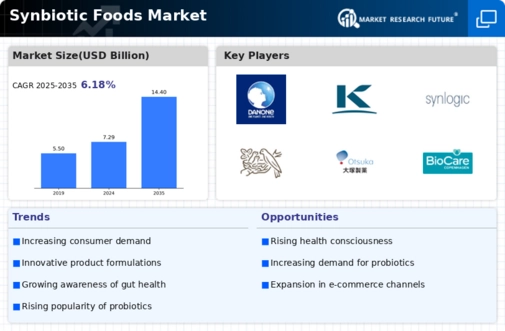The Synbiotic Foods Market has seen significant growth, fueled by increasing consumer awareness regarding the benefits of gut health and the rising trend toward functional foods. This market is characterized by the integration of prebiotics and probiotics in food products, creating a synergistic effect that enhances digestive health and overall well-being. This sector is witnessing robust competition as established players and new entrants strive to innovate and differentiate their offerings.
The landscape of the market is diverse, with products catering to various dietary needs and preferences, emphasizing clean labels and natural ingredients. The competitive dynamics are influenced by factors such as product formulation, marketing strategies, and distribution channels, which are crucial for capturing consumer interest and loyalty in a crowded marketplace.
Danone holds a strong position within the Synbiotic Foods Market, leveraging its extensive portfolio that includes a range of dairy and plant-based products fortified with Synbiotics. The company's strengths include a well-established brand reputation for quality and nutritional value, which resonates well with health-conscious consumers.
Danone focuses on continuous product innovation, developing new Synbiotic formulations that cater to various health needs, including digestive health, immunity support, and dietary inclusivity. This strategic emphasis on health and wellness has enabled Danone to effectively meet consumer demands while maintaining a competitive edge against both local and international brands.
Additionally, Danone's robust distribution network and strategic partnerships enhance its market presence, making Synbiotic products readily accessible to a wide audience.
Kerry Group is another key player in the Synbiotic Foods Market, recognized for its commitment to delivering innovative and quality ingredients that cater to the growing demand for functional foods. The company combines its extensive expertise in food science with a focus on health-oriented products, providing customized Synbiotic solutions to manufacturers across the food and beverage industry.
Kerry Group's strengths lie in its advanced research and development capabilities, enabling the creation of unique formulations that incorporate both probiotics and prebiotics effectively. Furthermore, Kerry's strong global footprint allows it to tap into emerging markets and foster collaborations with various brands, enhancing its visibility and influence in the Synbiotic foods sector.
The company's focus on sustainability and clean-label products aligns with current consumer trends, making its offerings increasingly appealing in the competitive landscape of the market.


















Leave a Comment